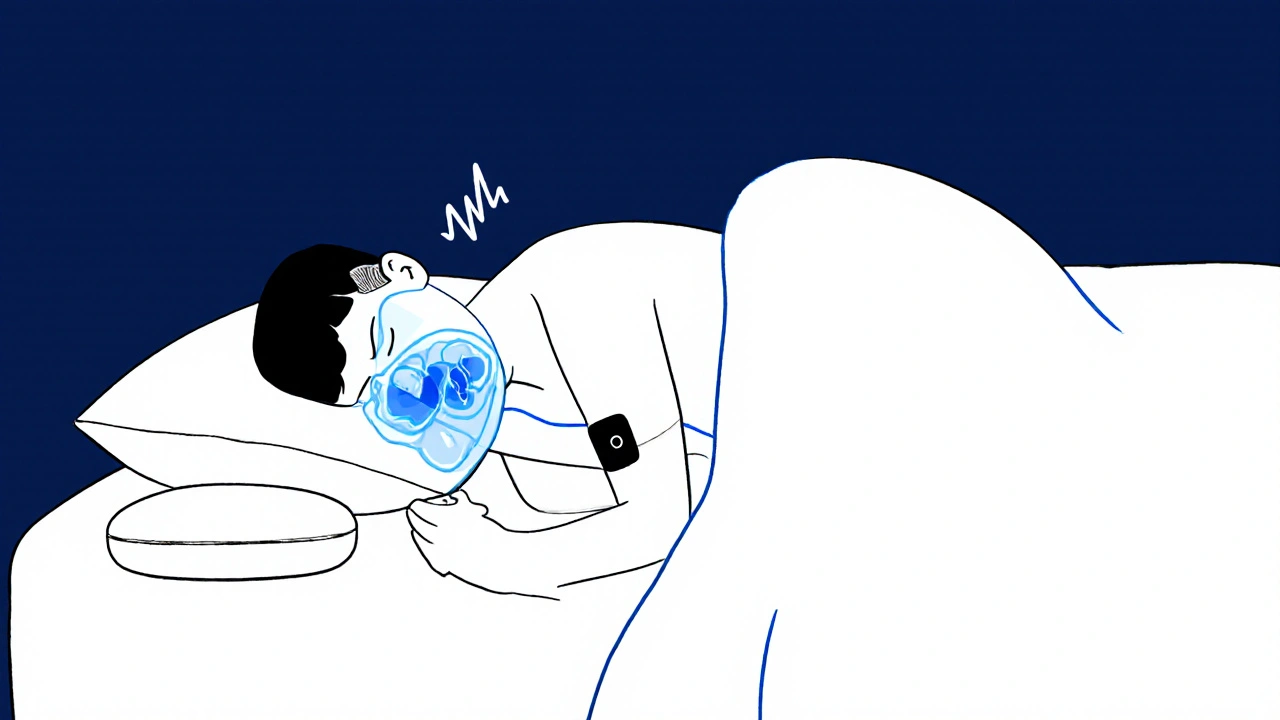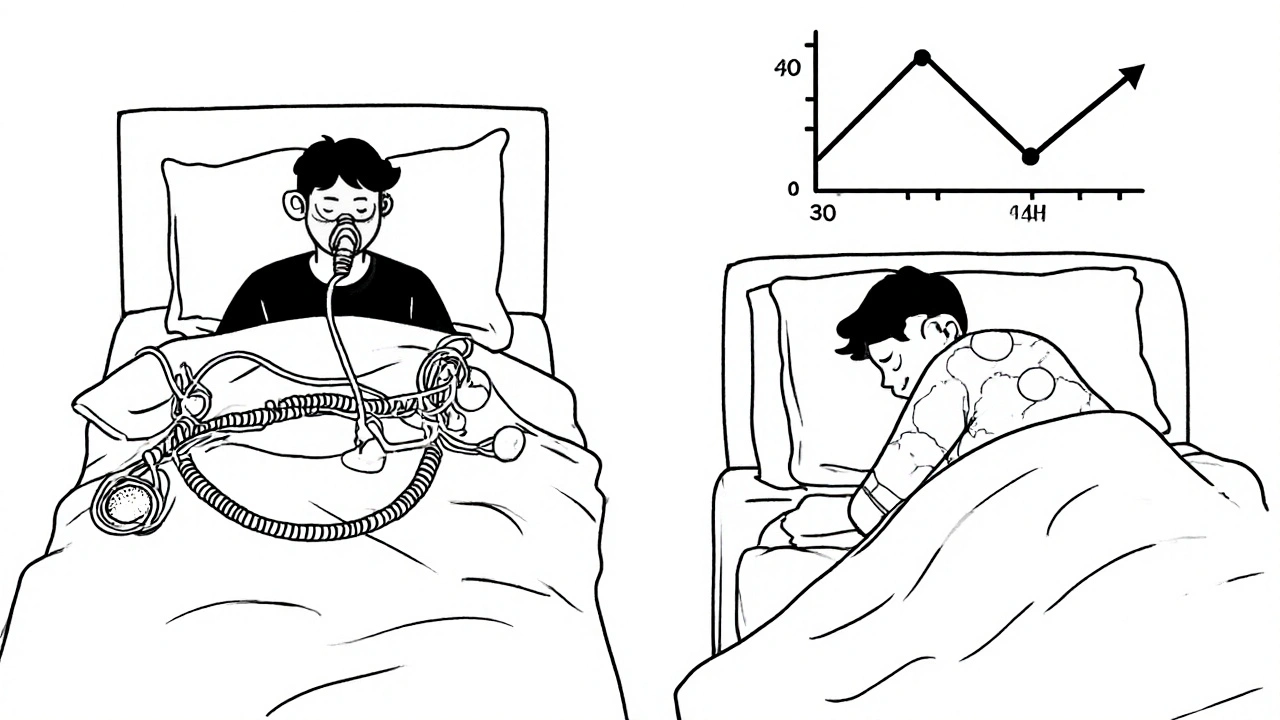Why Sleeping on Your Back Makes Sleep Apnea Worse
If you have sleep apnea, the position you sleep in can make a huge difference-sometimes the difference between breathing normally and choking off multiple times an hour. Sleeping on your back, called supine sleeping, is the worst position for obstructive sleep apnea (OSA). Gravity pulls your tongue and soft tissues in your throat backward, narrowing your airway by 30-40%. This isn’t just theory; studies show that for many people, the number of breathing interruptions jumps from fewer than 5 per hour on their side to 30 or more when they roll onto their back.
That’s why doctors call this positional obstructive sleep apnea (POSA). It’s not that your airway is always blocked-it’s only blocked when you’re lying flat on your back. The good news? You don’t need a machine to fix it. Simply sleeping on your side can cut your apnea events in half, or even eliminate them entirely.
What Is Positional Therapy?
Positional therapy is exactly what it sounds like: training yourself to avoid sleeping on your back. It’s not about fancy pillows or expensive mattresses. It’s about changing your body’s habit of rolling onto your back during sleep. The goal? Keep your airway open by staying on your side.
This approach is backed by the American Academy of Sleep Medicine and the American Academy of Family Physicians. They recommend it for people with positional OSA-those whose apnea-hypopnea index (AHI) is at least double when lying on their back compared to lying on their side. If your sleep study shows this pattern, positional therapy could be your most effective, low-cost solution.
Simple Methods: The Tennis Ball Trick
The oldest and cheapest trick? Sew a tennis ball into the back of your pajama top. It’s uncomfortable to lie on it, so your body learns to avoid that position. Many people swear by it. But it’s not perfect.
Some users report waking up sore or frustrated because the ball digs into their skin. One informal survey found that nearly half of people who tried this method gave up within three months. It works for some, but it’s not sustainable for most. If you’re looking for something gentle and reliable, this isn’t it.
Advanced Solutions: Wearable Vibration Trainers
Modern positional therapy uses smart devices like the Sleep Position Trainer (SPT) or NightBalance. These are lightweight, belt-like devices worn across the back. When you roll onto your back, they vibrate softly-just enough to nudge you back onto your side, without waking you up.
A 2015 study in the Journal of Clinical Sleep Medicine compared the tennis ball method to the SPT. Both reduced time spent on the back to nearly 0%. But here’s the key difference: 68% of SPT users reached treatment success (AHI under 5), while only 43% of tennis ball users did. More importantly, SPT users stuck with it longer. Compliance was over 30% higher.
Why? Because the vibration doesn’t hurt. It doesn’t wake you. It just reminds you. And that makes all the difference. These devices cost $300-$400, but if you’ve struggled with CPAP, they’re often worth it.

Positional Therapy vs. CPAP: Which Works Better?
CPAP-the machine that blows air into your airway-is still the gold standard. It lowers your AHI more than any other treatment. But here’s the catch: most people quit using it. Studies show only about 50-60% of CPAP users stick with it long-term.
Positional therapy? Adherence rates are 35-40% higher. Why? Because you’re not wearing a mask, dealing with noise, or cleaning hoses. You’re just sleeping. And if your apnea is position-dependent, you don’t need CPAP. You just need to stay on your side.
Experts agree: if your sleep study shows clear positional dependence, positional therapy should be your first try. It’s less invasive, cheaper, and easier to live with. CPAP stays the top choice for severe, non-positional apnea-but for the rest, side sleeping might be all you need.
Who Should Try Positional Therapy?
Not everyone with sleep apnea benefits from positional therapy. You need to have positional OSA. That means your breathing problems happen mostly or only when you’re on your back.
To know for sure, you need a sleep study that tracks your breathing by position. Most labs now do this automatically. If your supine AHI is at least twice your side AHI, you’re a candidate. If your AHI is high no matter how you sleep, positional therapy won’t help much.
Also, don’t assume side sleeping fixes everything. Some people still snore or have mild apnea on their side. But even then, it’s better than the back. And if your partner notices your snoring stops when you turn over-that’s a sign positional therapy could work for you.
What About Central Sleep Apnea?
Positional therapy works best for obstructive sleep apnea, where your airway collapses. It’s less effective for central sleep apnea, where your brain doesn’t send the right signal to breathe. That’s a different problem, often tied to heart or neurological conditions.
That said, some research suggests side sleeping might help central apnea too-possibly by improving lung expansion and nerve signaling. But the effect is weaker. If you have central apnea, talk to your doctor before skipping CPAP or other treatments.

Real-World Results: What Patients Actually Experience
People who stick with positional therapy report life-changing results. Snoring drops off almost instantly when they turn onto their side. Partners sleep better. Daytime fatigue fades. One user said, “I didn’t realize how tired I was until I stopped waking up 20 times a night.”
And the benefits go beyond sleep. Lying on your back increases stress on your heart and raises your risk of high blood pressure and stroke. By staying on your side, you’re not just sleeping better-you’re protecting your heart.
Still, it takes time. Most people need two weeks to adjust. Your body is used to rolling onto your back. Training it to stay on its side is like relearning how to sit up straight. Be patient. Use a pillow between your knees to keep your spine aligned. Prop your upper body up slightly with a wedge pillow. Small changes add up.
What’s on the Market Today?
You’ve got options, from DIY to high-tech:
- Tennis ball method - Free or under $5. Works for some, fails for most.
- Specialized side-sleeping pillows - $20-$50. Designed to cradle your body and prevent rolling. Helpful, but not always enough.
- NightBalance or Sleep Position Trainer - $300-$400. Wearable, vibration-based. Highest success and compliance rates.
- Smart Nora - Around $500. Uses gentle air pulses to open your airway when snoring starts. More expensive, but works for those who still snore on their side.
Market growth is accelerating. Since 2020, adoption of wearable positional devices has jumped 25% per year. More people are realizing: you don’t need a machine to breathe at night. You just need to sleep in the right position.
Next Steps: How to Get Started
- Check your sleep study results. Look for your supine and side AHI numbers. If supine is at least double, you’re a candidate.
- Try the tennis ball trick for a week. If it’s too uncomfortable or you wake up sore, skip it.
- Consider a wearable device if you’ve tried CPAP and quit, or if you want something quieter and simpler.
- Use a wedge pillow or elevate your head 6-8 inches to help keep your airway open.
- Track your progress. Use a sleep tracker or ask your partner if snoring has dropped.
Don’t wait for a diagnosis to try side sleeping. Just start sleeping on your side tonight. Put a pillow behind your back. Roll over when you wake up. It’s free, safe, and often life-changing.
Frequently Asked Questions
Can sleeping on my side cure sleep apnea?
For people with positional obstructive sleep apnea (POSA), yes-sleeping on your side can reduce or eliminate breathing interruptions. If your apnea only happens when you’re on your back, switching to side sleeping can bring your AHI from severe to normal. But if you have apnea no matter your position, side sleeping alone won’t be enough. You’ll still need CPAP or another treatment.
Is the tennis ball method effective?
It can work, but it’s not ideal. About 45% of people stop using it within three months because it’s uncomfortable and disrupts sleep. It’s a low-cost test to see if positional therapy might help. If you feel better sleeping on your side after a week, consider upgrading to a wearable device for better results.
Do I need a sleep study to try positional therapy?
You don’t need one to try sleeping on your side-it’s safe for everyone. But to know if positional therapy will work for you, you need a sleep study that breaks down your apnea events by position. Without that data, you might be treating the wrong problem. If you’ve been diagnosed with OSA and haven’t had positional data checked, ask your doctor for a review.
How long does it take to adjust to side sleeping?
Most people adapt in 1-2 weeks. Your body is used to rolling onto your back, so it takes time to retrain. Use pillows to block rolling, sleep with a wedge under your upper back, and be consistent. After a few nights, you’ll start sleeping more deeply-and waking up less tired.
Are positional therapy devices covered by insurance?
Some insurance plans cover wearable positional devices like NightBalance or Sleep Position Trainer if you have a diagnosis of positional OSA and a prescription. Others don’t. Check with your provider. Even if it’s not covered, many HSA and FSA accounts allow you to use pre-tax dollars to pay for them.



